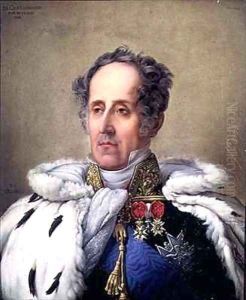Pierre Louis Delaval or De Laval Paintings
Pierre Louis Delaval, also known as Pierre Louis De Laval, was a French painter who lived during the 18th and early 19th centuries. Born in 1740, Delaval was a product of the Rococo era, a period that was characterized by elaborate ornamentation, asymmetrical values, pastel color palettes, and often, subjects that were light-hearted, sometimes frivolous.
Delaval's life spanned a period of significant upheaval in France, including the French Revolution and the Napoleonic wars. However, there is limited documentation about his life, which means that much of his biography is pieced together from his surviving works and the broader historical context of his time.
Delaval is known to have been active as an artist during the latter half of the 18th century. His work primarily consisted of portraits and historical scenes. These pieces were often created with fine detail and a delicate touch, reflecting the Rococo style's emphasis on grace and beauty. Delaval's portraits, in particular, may have catered to the French aristocracy, who were the primary patrons of the arts during this era.
Despite his work, Delaval did not rise to the same level of fame as some of his contemporaries, such as François Boucher or Jean-Honoré Fragonard, which might account for the relative obscurity of his biography. The French Revolution, which began in 1789, led to dramatic changes in the cultural landscape, with many artists of the Rococo style falling out of favor as Neoclassicism took hold.
Delaval lived through these turbulent times, and it is possible that the changing tastes and the political unrest affected his career. However, the details of how he navigated this period are not well-documented. He died in 1824, having witnessed the restoration of the French monarchy after Napoleon's defeat. His works, while not as widely known or celebrated as those of his peers, offer a glimpse into the artistic styles and social mores of his time.
